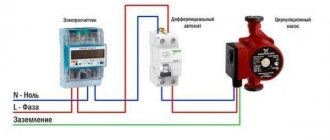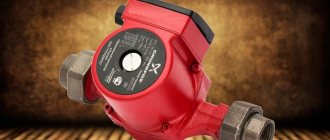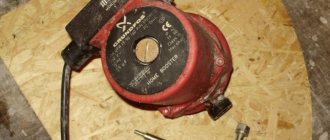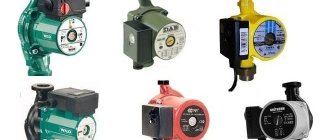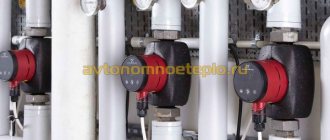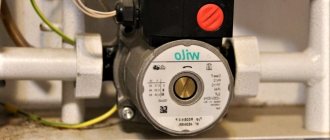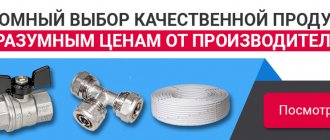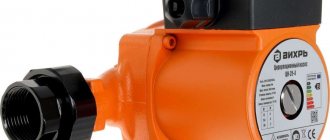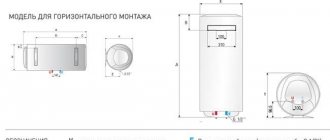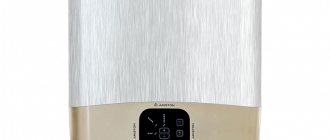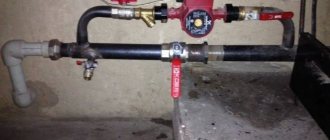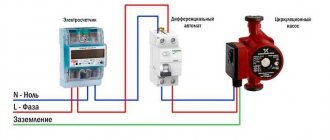What do we need to clean the pump?
1. Clean the pump parts
2. Polish the inner walls of the pump
3. Cleaning the flow sensor
4. Find out the reasons for stopping the pump
5. After disassembling and cleaning the pump
In addition to a wide range of well pumps, GRUNDFOS also produces circulation pumps for heating systems. The task of the circulation pump is to organize a constant and uniform flow of coolant through the pipes from the boiler to the heating devices and back. GRUNDFOS pumps are known for their reliability. But any equipment eventually either breaks down or its performance gradually deteriorates due to wear of parts and the accumulation of various contaminants, depending on operating conditions and the type of liquid being pumped. The circulation pump must be kept in working condition at all times.
If such a pump breaks down, the heating system will stop and the room will be cold. At low winter temperatures and prolonged downtime of the heating system, there is a risk of freezing and failure of the water supply system, as well as other equipment and containers containing water. Considering the difficult operating conditions in a heating system in a flow of highly heated coolant, the main reasons for failure of the GRUNDFOS circulation pump are solid deposits on the walls and components. Under such conditions, the efficiency of the pump and, consequently, the heating is reduced. The appearance of deposits is only a harbinger of an accident that can be avoided by cleaning the equipment. Even if you purchase a new circulation pump, a refurbished old one can be used as a spare.
GRUNDFOS circulation pump in the heating system
Cleaning pump parts
To return the circulation pump to its original performance, it is necessary to clean its two main parts - the shaft and the rotor. How to get to these pump components? Using a hex wrench, we disassemble the threaded connection that connects the pump and the motor. Having opened the pump, we check the level of rust deposits inside.
circulation pump device
If cleaning is necessary, use a piece of hard cloth or a scraper. For more thorough cleaning, use a screwdriver inserted into the grooves around the support washer, remove the washer, and disassemble the rotor with the impeller. Based on the condition of the surface of the parts, you can approximately determine how soon rust deposits will appear on them. On a smooth surface, there will be nothing for foreign particles to cling to. Therefore, after inspecting the pump parts, if necessary, you can polish them - use a grinding wheel. The next step is to check the condition of the stator. If there is severe oxidation, the stator is also cleaned.
Price list for equipment services
| Site visit | Price, rub.) | ||
| Moscow within the Moscow Ring Road | 4500,00 | ||
| To the city and region up to 50 km from the Moscow Ring Road | 5500,00 | ||
| To the area up to 70 km from the Moscow Ring Road | 6000,00 | ||
| up to 100 km from MKAD | 7500,00 | ||
| up to 200 km from MKAD | 8500,00 | ||
| For every subsequent 50 km from the Moscow Ring Road | 1200,00 |
* Departure to the site includes the travel time of two specialists * The minimum paid time of specialists on site is 2 hours * When leaving, household equipment is paid as industrial equipment up to 4.0 kW.
Diagnostics of Grundfos pumping equipment
Urgent diagnostics in the service - cost increase factor 1.5 Diagnostics in the service of E-pumps (with frequency drive) - coefficient. price increase 1.8
| Types of pumping equipment | Unit change | Price (RUB) at the service center | Price (RUB) on site |
| On-site pump diagnostics | 1hour/work | — | from 4400.00 |
| Household pumps - diagnostics | |||
| UPS, Alpha, UP, Comfort, Solar | 1 PC | 900,00 | from 4400.00 |
| JP, MQ, Scala, SQ, SQE, KP | 1 PC | 1200,00 | from 4400.00 |
| Sololift, AP, SB, SBA, SPO, SP-A | 1 PC | 1400,00 | from 4400.00 |
| Industrial pumps - diagnostics | |||
| CM, CH, NB, TP, LP up to 4 kW | 1 PC | 2400,00 | from 4400.00 |
| CM, CH, NB, TP, LP up to 11 kW | 1 PC | 2900,00 | from 5200.00 |
| CR, CRN, MTR, CRT, SP up to 4 kW | 1 PC | 3600,00 | from 4400.00 |
| CR, CRN, MTR, CRT, SP up to 11 kW | 1 PC | 3900,00 | from 5200.00 |
| UPS 200, MAGNA 1.3 | 1 PC | 2100,00 | from 4400.00 |
| SEG, SEV, SL, DP up to 4 kW | 1 PC | 3300,00 | from 5400.00 |
| SEV, SL, DP up to 11 kW | 1 PC | 5500,00 | from 6600.00 |
| SL, SE, SV, S up to 30 kW | 1 PC | 12600,00 | from 7900.00 |
| SPS diagnostics (without disassembling the pump unit) | 1hour/work | — | from 8200.00 |
| M/MD Station Diagnostics | 1 PC | — | 12400,00 |
Repair of Grundfos pumping equipment
| Pressure boosting and circulation pumps Grundfos | Unit change | Price (RUB) at the service center | Price (RUB) on site |
| Domestic pumps | |||
| UPS, Alpha, UP, Comfort, Solar | 1 PC | 900,00 | from 4400.00 |
| JP, MQ, Scala, SQ, SQE, KP | 1 PC | 1800,00 | from 4400.00 |
| Sololift, AP, SB, SBA, SPO, SP-A | 1 PC | 2200,00 | from 4400.00 |
| Industrial pumps | |||
| UPS 200, MAGNA 1.3 | 1hour/work | 2100,00 | from 4400.00 |
| CM, CH, NB, TP, LP,CR, CRN, MTR, CRT, SP up to 4 kW | 1hour/work | 2400,00 | from 4400.00 |
| CM, CH, NB, TP, LP,CR, CRN, MTR, CRT, SP up to 11 kW | 1hour/work | 3100,00 | from 5200.00 |
| pumps up to 22 kW | 1hour/work | — | from 6400.00 |
| pumps up to 45 kW | 1hour/work | — | from 7600.00 |
| pumps over 45 kW | 1hour/work | — | on request |
| Sewage pumps Grundfos | Unit change | Price (RUB) at the service center | Price (RUB) on site |
| SEG, SEV, SL, DP up to 4 kW | 1hour/work | 3400,00 | from 5400.00 |
| SEV, SL, DP up to 11 kW | 1hour/work | 5500,00 | from 6600.00 |
| SL, SE, SV, S up to 30 kW | 1hour/work | 7600,00 | from 7900.00 |
| M/MD | 1hour/work | — | from 7100.00 |
| Diagnostics and service work, electronic parts | Unit change | Price (RUB) at the service center | Price (RUB) on site |
| Household automation and control room without controller | 1hour/work | 2100,00 | from 4400.00 |
| Control cabinet with controller | 1hour/work | 5200,00 | on request |
| Frequency converter | 1hour/work | 4100,00 | on request |
| Industrial pump | 1 PC | — | 15000,00 |
Laser alignment of pump shafts and other equipment
| pump up to 11 kW | 1 PC | — | from 17000 |
| pump up to 37 kW | 1 PC | — | from 19000 |
| pump up to 160 kW | 1 PC | — | from 31000 |
| pump up to 200 kW | 1 PC | — | from 45000 |
| pump over 200 kW | 1 PC | — | on request |
Cleaning the Flow Sensor
It is important to keep the flow sensor clean. Sludge and rust change the sensitivity and characteristics of the sensor, resulting in reduced pump performance. If the sensor is heavily contaminated, the pump may shut down completely. Therefore, when cleaning the pump parts, do not forget to clean the sensor as well.
flow and temperature sensor
How to remove the sensor from the circulation pump? To do this, remove the cover from the control unit and disassemble the pump housing into two halves. Next, use the wrench that comes with the pump to unscrew the screws and the sensor can be easily removed. If the sensor cannot be removed due to accumulated dirt, pry it off with a screwdriver. The sensor body is made of plastic, so when cleaning it, do not use aggressive chemicals or abrasives - use a regular toothbrush.
Professional repair of Grundfos well pumps
Experts carefully determine the technical condition of the equipment, the feasibility and justification of its restoration. This allows you to choose a rational and inexpensive solution. Then we disassemble the system and replace worn parts and mechanisms. Routine repair of a Grundfos pump can take several hours.
If your lifting device has problems, contact LIMISH immediately. We recommend that you first familiarize yourself with the current tariffs for eliminating typical equipment breakdowns presented in the Table. High-quality repair of a Grundfos pump will restore the source’s functionality at minimal cost. Specialists are ready to travel at your request to carry out Grundfos repairs on site.
We find out the reasons for stopping the pump
The pump may stop working due to bearing seizure, sensor failure, or low pressure in the heating circuit. How to find out what really happened? To find out the reason for the stop, it is not always necessary to disassemble the pump. Switch the heating equipment to manual mode. To do this, place the switch located on the junction box in the middle position. In this mode, the pump can operate even when the tap is closed.
GRUNDFOS circulation pump in line with bypass
If the pump does not turn on in manual mode, then the reason is internal - you need to disassemble the product and rotate the impeller. If the impeller does not spin, the pump cannot be repaired. If the impeller rotates manually, then the reason for stopping the pump is a broken flow water sensor. To restore pump functionality, replace the sensor. It happens that the circulation pump stops due to air accumulated in it. To bleed off excess air, turn the central screw.
Stages and rules of repair
Repair of the Sololift pump, as well as repair of a Grundfos pumping station for any purpose, can be done independently, having first identified the source of the problem.
Equipment diagnostics involves several stages:
- start the pumping station, assess the noise and vibration levels;
- check the pressure indicators;
- make sure that the motor does not overheat during operation;
- check the presence and quality of lubrication of node connections;
- make sure the integrity of the structure and the absence of leaks;
- inspect the box for secure fixation of the terminals.
If you are sure that the malfunctions are not caused by lime deposits and contamination, overloads or operation at maximum power, the pump can be disassembled. When planning to repair the Grundfos pump yourself, make sure that the water is drained from the pipelines and turn off the system. Disassembly begins with the junction box and visual assessment of components. As a rule, such an inspection makes it possible to immediately detect a burnt out or worn out part. If not, we will continue to disassemble the installation.
The engine must be in a vertical position during disassembly . This will prevent the risk of oil leakage. To diagnose the starting mechanism, you must connect an ohmmeter to the engine. This instrument, when rotating the handle, generates a voltage in the range of 200-300 V, sufficient to take readings on a resistance meter. Diagnostic data that is too high, reaching infinity, indicates a break in the working phase, too low - an interturn short circuit. Independent adjustment of operating parameters with such deviations is impossible.
After disassembling and cleaning the pump
After cleaning and checking all parts of the GRUNDFOS pump, carefully reassemble it in reverse order. If all the actions taken do not force the pump to turn on, then there is a possibility of failure of the motor winding or capacitor. This type of repair requires the availability of spare parts that can only be provided by a service center. In the absence of a SC, the entire pump will have to be replaced. Taking into account the fact that in Europe in general water contains less various mechanical and chemical contaminants, in our conditions the guaranteed life of the pump can be reduced by a year or two.
How to carry out regular pump maintenance?
From time to time, preferably at least once a month, it is necessary to carry out an external inspection and check the quality operation of your circulation pump device.
Pump design option
- Turn on the pump and in operating mode, check for any extraneous noise or excessive vibration.
- Check the coolant pressure supplied by the pump. It must correspond to the indicators stated in the technical data sheet.
- Make sure that the electric motor of the device does not become overheated.
- Check the presence of grease on the threaded flanges and, if necessary, restore it.
- Make sure there is a ground connection between the pump housing and the appropriate terminal.
- Inspect the pump from all sides and make sure there are no leaks. Typically, such vulnerable points are the interface between the pipeline and the housing of the pumping device. Check the tightening level of the bolts and the normal condition of the gaskets.
- Inspect the terminal box. All wires must be securely fixed. The presence of moisture in the unit is unacceptable.
Types of pumping stations
NS may differ in various ways:
- Pump type: depending on the depth of the source, self-priming pumps (up to 8 m) and submersible ones are used. By type of pumping mechanism, most are of the centrifugal type, but among submersible models there are often vibration ones.
- Type of automation: if water flow is carried out exclusively in a continuous mode, for example, for irrigation, instead of a pressure switch, a flow sensor is installed on the pump. It turns on the pump when water is drawn (it reacts to the movement of the medium in the pipe) and turns off when it ends. A hydraulic accumulator is not used in such a PS. Some NS models with flow sensors and without a storage tank can also be used in regular home plumbing. They are equipped with advanced automation, which “can” smoothly start/stop the pump engine and change its power. If such functions are available, frequent switching on will not be a problem for the unit.
- Hydraulic accumulator type.
Pumping station working
Two types of hydraulic accumulators are used in PS:
- balloon: water is pumped into a rubber “bulb”;
- membrane: volumes for air and water are separated by an elastic membrane.
Also, drives may differ in capacity. It should be taken into account that the specification indicates the volume of the entire tank, and not the water tank in it.
Autonomous water supply in the house is an important component of comfortable living. Well or borehole - which is better for a country house or cottage? We'll help you figure it out.
You can familiarize yourself with the operating principle of a bio-toilet for a summer residence here.
For tips on making a vacuum press with your own hands, read this publication.
Main causes of malfunctions
Let's mentally walk through the NS and see what can cause malfunctions in its operation.
Suction line (for systems with self-priming pumps)
After the unit is turned off, it is held in place by a check valve installed at the beginning of the water intake pipe.
During long periods of inactivity, the pump must be refilled.
If you are looking for a self-priming pump that does not need to be primed, choose a vortex type unit. However, keep in mind that it has very low efficiency.
The lack of water in the suction line may be due to the following reasons:
- the water in the source has dropped below the intake pipe;
- the check valve is not functioning properly;
- cracks or gaps appeared in the line through which air entered it (the water column ruptured).
Symptoms
If the pump is equipped with a dry running sensor, the pump will automatically turn off. Otherwise, it will work (until the overheating protection is triggered), but no water will flow.
Pump
The following troubles can happen to the main element of the NS:
- impeller sticking: a hum is heard, but the motor does not rotate;
- the capacitor has failed: the symptoms are the same;
- due to wear of the housing and impeller, the pump cannot develop a pressure in the pipeline at which the pressure switch is activated: the unit does not turn off even with zero water flow;
- The engine is burnt out: the unit does not turn on, the smell of burnt insulation is heard.
Pumping station with built-in ejector
Pressure switch
Most often, the relay stops functioning for the following reasons:
- Dirt has accumulated on the contacts, preventing the electrical connection: the pump has stopped turning on;
- the connecting pipe is clogged: the relay stops responding to changes in pressure in the water supply;
- the springs weakened, as a result of which the boundaries of the operating pressure range “floated”.
Water pipes
Signs of a clogged pipeline depend on where the relay is installed:
- the relay is located in the house next to the hydraulic accumulator, that is, a plug has formed somewhere between it and the pump: pumping water into the hydraulic accumulator began to take longer than usual;
- the relay is installed next to the pump, that is, it is located between it and the plug: the unit operates jerkily (frequent on/off).
DIY pumping station repair
To resume the work of the NS, you must do the following:
Suction line
Do-it-yourself check valve repair usually involves removing dirt or long-fiber debris that is preventing the valve from closing. For more complex breakdowns, the part is replaced.
If cracks appear on the reinforced hose through which the pump sucks air, they must be sealed with reinforced tape for repairing pipelines.
Pump
A worn housing or impeller will need to be replaced.
There are models in which a stainless steel liner is installed into the cavity. It is much cheaper to replace it than the entire body.
Cleaning the contact group and connecting pipe from dirt usually does not cause any difficulties for users.
By the way, it is best to remove plaque from contacts with a soft school eraser.
The relay is adjusted by rotating two nuts screwed onto the rods with springs on them.
The value of the switch-on pressure (also called lower) depends on the degree of compression of the large spring, and the small one regulates the difference between it and the switch-off pressure (upper). Please note, not the cut-off pressure itself, but the difference between the upper and lower pressures.
If the pump, due to wear, cannot develop sufficient pressure to shut down, you need to wait until the pressure gauge needle freezes at the maximum mark, and then manually turn off the power to the unit. Next, gradually loosen the small spring nut until the contacts click.
